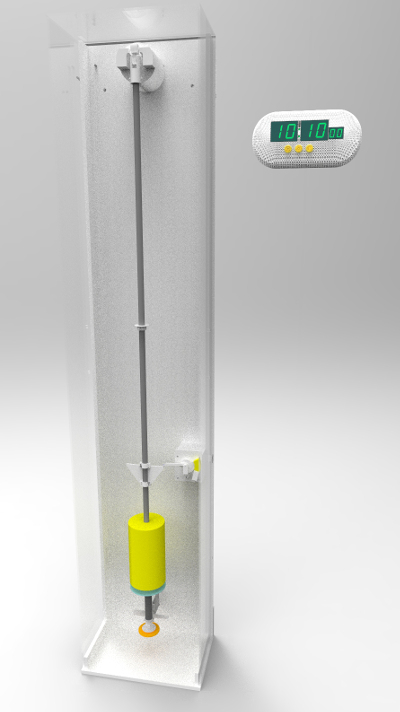|
Precision timing has fascinated mankind ever since Galileo’s discovery of the stability of pendulums in the Cathedral of Pisa. Pendulums as timekeepers have been
studied theoretically and practically ever since then. Until the introduction of atomic clocks in the 1950s pendulums were the basis for all precision timing
around the world. Pendulum clocks have something satisfying and grounding in them, their accuracy as it is depending on the characteristics of our earth,
some of the timing errors seen caused by the universe around us.
The Principle
Through the years many clockmakers and physicists have spent much time improving the characteristics of pendulum clocks. The best results culminated in the timekeepers made by
Mr. William Harrison Shortt, who’s clocks were the last pendulums used for international time standards before atomic clocks were introduced. These Shortt clocks
achieved timekeeping to better than a tenth of a second a year. These clocks contained two pendulums, the “master”, a free pendulum which did the
timekeeping and a “slave” timepiece that indicated the time and did all the work for the master. The master was impulsed by the slave
once every 30 seconds and placed in a vacuum tank to reduce the losses caused by friction with air and the timekeeping errors caused by changes in barometric pressure.
The slave pendulum was synchronised to the master pendulum and thus was as accurate as the master pendulum. The master pendulum did no work other than tell the slave
its exact position once every 30 seconds. This tiny amount of the work that the master needed to do resulted in very few disturbances and thus its excellent timekeeping.
The Ingénieur du Temps hPPC is based on this same principle. The master is a free pendulum which is impulsed by the slave and does no work other than
tell the slave its exact position. The slave is, however, not another pendulum clock, but an electronic 7-segment LED display.
Knowing the exact position of the master the slave gives the master an impulse every 60 seconds and synchronises with the master.
Sourcing the best of both mechanical and electronic clocks, the clock proudly carries it's name “Hybrid Precision Pendulum Clock”
The Design
In today’s fast paced world a pendulum with a 2 second period provides a visual indication of time's passing and with its slow methodical movement calms its surroundings.
Conceived as an atmospheric pendulum in a transparent glass and metal housing the hPPC fits perfectly in any private or professional surrounding.
It will become a center of life and discussion reminding us that we are a part of a bigger universe.
As with the Shortt pendulums the master and slave are in separate housings connected only with an electrical cable for the few signals necessary for impulsing and synchronisation.
The master housing contains the pendulum with its temperature and barometric pressure compensation along with the gravity arm impulsing unit.
The slave housing contains the digital LED time display and the logic to impulse the master at the proper time every 60 seconds.
The two housings can be placed together or separated by the length of the 2 meter connecting cable.
The system also contains a battery backup which assures operation of the clock during several hours if grid power is lost.
Specifications
Master | |
| Oscillation period: | 2 seconds (1 second beat) |
| Pendulum rod: | Fused silica |
| Pendulum weight: | Brass, 6kg |
| Compensation: | Temperature and barometric pressure |
| Impulse method: | Gravity arm, electronically triggered by the Slave |
| Case: | High quality aluminium (608X) and glass |
Slave | |
| Time indication: | Hours, minute and seconds, 24 hour or 12 hour display
Seven segment LEDs, hours and minutes 25.4mm, seconds 14.2mm
Several LED colors are available. |
| Time setting: | Through 3 push-buttons, setting mode |
| Time correction: | Through 3 push-buttons, correction mode
(add or subtract either 1 hour (summer/winter time) or up to 9 seconds
to the current time) |
| Synchronisation: | Through optical barriers on the Master pendulum |
| Case: | Made through additive techniques in high quality plastic on a 3D printer.
Several materials and many colors are available.
The 3D printing time for the case is about 45 hours. |
The hPPC is powered by a 12V battery which will run the clock for about 12 hours in case of a power failure. The power supply unit includes the battery and a charger to maintain the battery fully charged.
The battery is a special long life unit designed
especially for such back-up power supply usage, but it is recommended to change the battery with a corresponding type about every 5 years to have no surprises in the case of a power failure.
The charger incorporated in the power supply unit is an international charger working correctly with input voltages from 90VAC to 264VAC and at 47Hz to 63Hz.
Introductory price CHF 32'000.- plus shipping
|




|